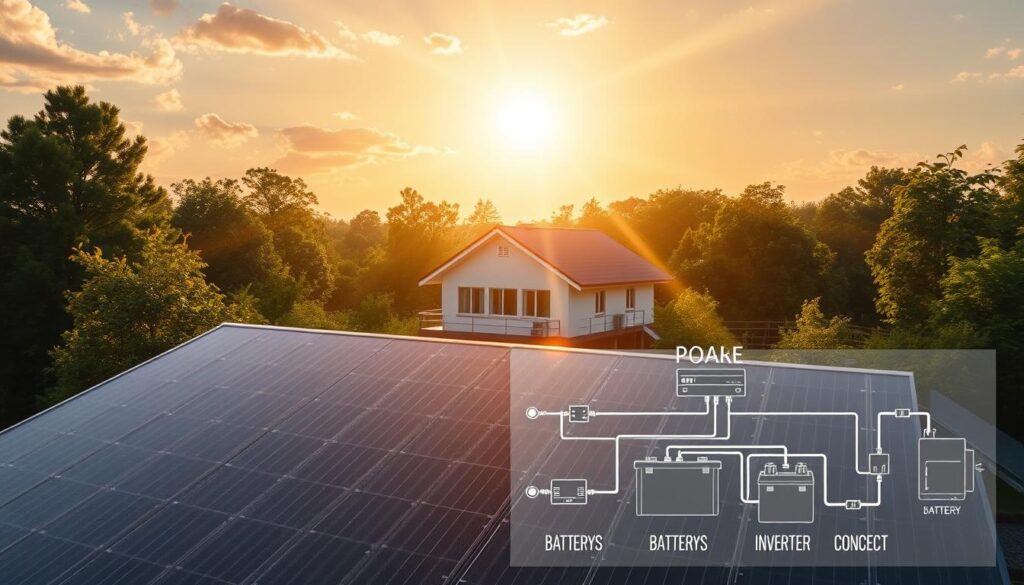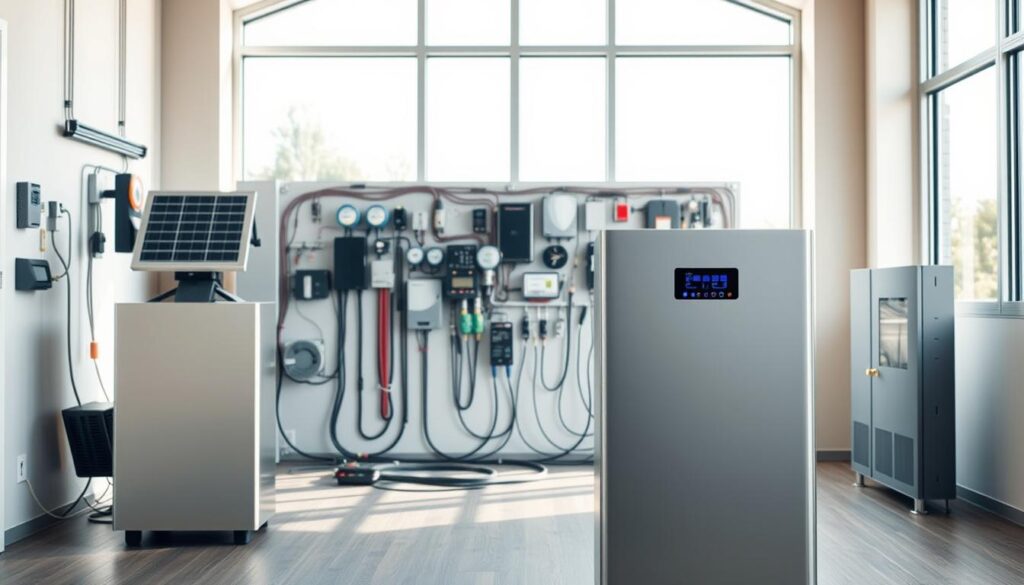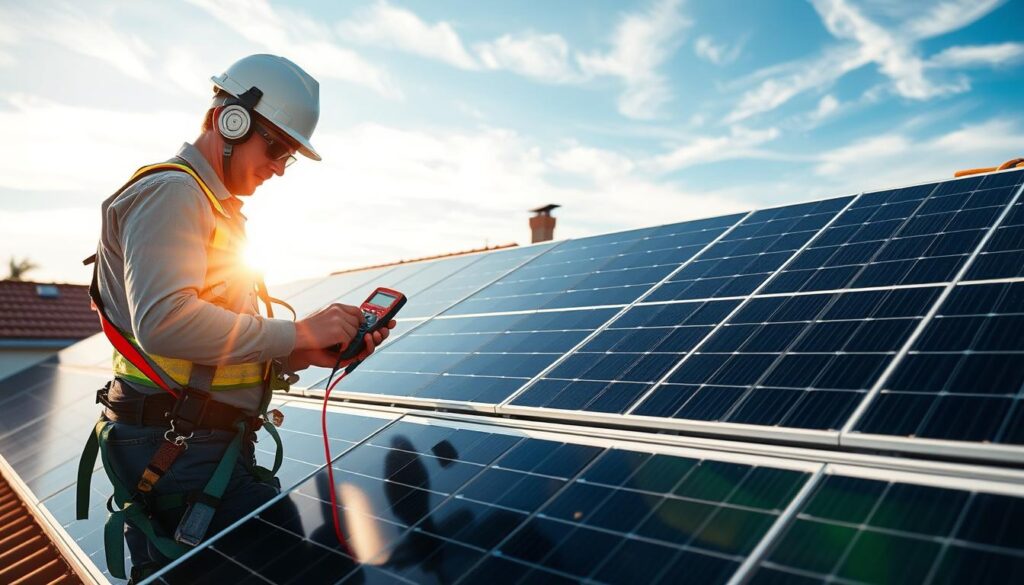Imagine powering your life with a clean, renewable source that’s been shining above us for billions of years. Solar energy has become a game-changer for homeowners across the United States, offering a sustainable way to reduce costs and environmental impact. Since 2008, advancements in technology and investments by the U.S. Department of Energy have made it more accessible than ever.
Today, hundreds of thousands of panels are installed nationwide, transforming how we think about power. Whether you’re looking to cut utility bills or contribute to a greener planet, a solar system can be a smart choice. This article will guide you through the process, from installation and costs to maintenance and financing options.
You’ll also discover the variety of solar solutions available and how incentives can make the switch even more affordable. Let’s dive into the world of renewable energy and explore how you can harness the sun’s power for a brighter future.
Key Takeaways
- Solar energy is a clean, renewable source that reduces costs and environmental impact.
- Advancements since 2008 have made solar more accessible and affordable.
- The U.S. Department of Energy has played a key role in promoting solar projects.
- This guide covers installation, costs, maintenance, and financing options.
- Incentives and diverse solutions make switching to solar easier than ever.
Understanding the Benefits of Solar Energy for Your Home
Switching to renewable power offers more than just savings—it’s a step toward a cleaner future. By harnessing the sun’s rays, you can reduce your reliance on fossil fuels and contribute to a healthier planet. Let’s explore how this choice can benefit you and the environment.
Environmental Impact and Energy Independence
Using renewable power significantly cuts down on harmful emissions. This helps combat climate change and reduces air pollution. By installing panels, you’re not just saving money—you’re making a positive impact on the environment.
Energy independence is another key advantage. With a grid-tied setup, you can generate your own electricity. This means less reliance on utility companies and more control over your power usage. Plus, excess energy can be fed back into the grid, earning you credits through net metering.
Long-Term Savings and Incentives
One of the biggest perks of going renewable is the long-term savings. Over time, your electricity bills can drop significantly. Many homeowners see a return on their investment within 5 to 15 years.
Financial incentives make the switch even more appealing. The federal tax credit, for example, allows you to claim up to 30% of the installation cost. State rebates and local programs can further reduce expenses. These incentives make renewable power an affordable option for many households.
- Reduce your carbon footprint while saving money.
- Gain energy independence with a grid-tied setup.
- Take advantage of tax credits, rebates, and net metering.
Getting Started with Solar: A Beginner’s Guide
Taking the first step toward renewable power begins with understanding your property’s potential. Evaluating your space and needs is essential to ensure a smooth transition. This guide will walk you through the basics of assessing your property and planning your installation.

Evaluating Your Property’s Solar Potential
Start by examining your property’s sunlight exposure. A south-facing roof typically receives the most sunlight, but tools like solar access calculators can provide precise measurements. Factors like shading, roof angle, and orientation also play a role in determining your cost and efficiency.
Next, review your current utility bill. Understanding your energy usage helps determine the size of the system you’ll need. This step ensures you maximize savings and avoid overspending on unnecessary equipment.
Basic Requirements for a Successful Installation
For a successful installation, your roof must be in good condition and have adequate space. Most systems require at least 150 square feet of unobstructed area. If your roof isn’t suitable, ground-mounted options are available.
DIY assessments can help you get started. Simple tools like sun path calculators and shade analysis apps provide valuable insights. However, consulting a professional ensures accuracy and helps you avoid costly mistakes.
Comparing Costs and Long-Term Savings
While the upfront cost of going solar can seem high, the long-term savings are significant. Many homeowners see a return on investment within 5 to 15 years. Incentives like tax credits and rebates can further reduce expenses, making it an affordable option for many.
“Planning and research are key to a successful transition to renewable power.”
By taking the time to evaluate your property and understand your needs, you can make an informed decision. This guide is your starting point to harnessing the sun’s power for a brighter, more sustainable future.
Assessing Your Energy Needs and Efficiency Upgrades
Understanding your energy consumption is the first step toward smarter, more efficient living. By reviewing your habits and making small changes, you can reduce waste and save money. This process also helps you determine the right size for your renewable project.
Reviewing Utility Bills and Consumption Patterns
Start by examining your monthly utility bill. Look for patterns in your usage, such as peak times or seasonal spikes. This data helps you identify areas where you can cut back. For example, high usage during summer might indicate a need for better insulation or a more efficient cooling option.
An energy audit is another valuable tool. Professionals can assess your property and pinpoint wasteful practices. They’ll check your roof, windows, and appliances to find opportunities for improvement. Many companies offer this service, making it easy to get started.
Identifying Opportunities for Energy Efficiency
Upgrading your property can lead to significant savings. Consider installing LED lighting, smart thermostats, or improved insulation. These changes not only reduce your bills but also make your space more comfortable.
Combining efficiency upgrades with renewable solutions maximizes your savings. For instance, a well-insulated roof ensures your panels work more effectively. Small improvements can have a big impact over time.
- Examine your utility bill to understand usage patterns.
- Conduct an energy audit to identify wasteful practices.
- Upgrade to LED lighting, smart thermostats, and better insulation.
- Combine efficiency upgrades with renewable solutions for maximum savings.
By taking these steps, you’ll not only meet your energy need but also create a more sustainable lifestyle. Start today and see the difference small changes can make.
Choosing the Right Solar Panels and Related Equipment
Selecting the right equipment is crucial for maximizing the benefits of renewable power. Whether you’re a homeowner or running a business, understanding your options ensures you get the most out of your investment. This section will help you compare panel types, mounting options, and kits tailored to your energy need.
Comparing Solar Panel Types and Solar Systems
Not all panels are created equal. Monocrystalline panels are known for their high efficiency and sleek design, making them ideal for limited spaces. Polycrystalline panels, while less efficient, are more affordable and suitable for larger installations.
Thin-film panels offer flexibility and lightweight design but require more space. When choosing, consider factors like efficiency, durability, and your specific energy need. Here’s a quick comparison:
| Panel Type | Efficiency | Cost | Space Requirement |
|---|---|---|---|
| Monocrystalline | High | $$$ | Low |
| Polycrystalline | Medium | $$ | Medium |
| Thin-Film | Low | $ | High |
Deciding on Roof-Mounted Versus Ground-Mounted Options
Roof-mounted systems are popular for their space-saving design and ease of installation. However, they require a sturdy roof and may face shading issues. Ground-mounted systems, on the other hand, offer flexibility in placement and easier maintenance but take up more space.
Consider your property’s layout and local zoning regulations when making this decision. For businesses with ample land, ground-mounted systems might be the better choice.
Warranty terms are another critical factor. Most panels come with a 25-year warranty, ensuring long-term performance. Look for products with minimal efficiency loss over time, such as those guaranteeing at least 84% capacity after 25 years.
“The right equipment ensures your investment pays off for decades.”
By evaluating your options and understanding your energy need, you can confidently choose the best setup for your property. Whether residential or commercial, the right equipment makes all the difference.
Installing Your Home Solar Energy System
Embarking on the journey to harness renewable power starts with a critical decision: DIY or professional installation. Both options have their merits, but understanding the differences can help you make the best choice for your needs. Let’s explore what each approach entails and how they impact your project’s success.

DIY Installation: A Cost-Effective Approach
For those with technical skills, DIY installation can save you thousands of dollars. A typical 6 kW setup might cost around $10,500 less than a professional installation. However, this option requires time, effort, and a solid understanding of electrical systems.
DIY projects involve assembling panels, connecting wiring, and ensuring proper alignment. Tools like sun path calculators can help optimize placement. While this approach is budget-friendly, it’s essential to follow local codes and safety guidelines to avoid costly mistakes.
Professional Installation: Reliability and Compliance
Hiring experts ensures your system is installed correctly and complies with local regulations. Professionals handle permits, wiring, and proper orientation for optimal electricity capture. They also ensure your setup meets utility requirements, reducing the risk of fines or delays.
Professional installers often provide warranties, giving you peace of mind. While the upfront price is higher, the long-term reliability and efficiency can make it a worthwhile investment.
Safety, Cost, and Utility Considerations
Safety is a top priority, whether you choose DIY or professional installation. Electrical work can be hazardous, so proper precautions are essential. Additionally, consider your local utility’s requirements, as some may mandate professional installation for grid-tied systems.
Cost is another factor. DIY saves money upfront but may require additional expenses for tools or repairs. Professionals offer a turnkey solution, ensuring your system operates smoothly from day one.
“The right installation method ensures your investment pays off for decades.”
By weighing the pros and cons, you can choose the approach that aligns with your skills, budget, and goals. Whether DIY or professional, a well-installed system will provide clean, reliable electricity for years to come.
Navigating Financing and Incentive Programs
Financing your renewable project doesn’t have to be overwhelming—options are more accessible than ever. From tax credits to loans, there are numerous ways to make your transition affordable. Let’s explore the financial tools and incentives available to help you get started.
Understanding Tax Credits and Rebates
The federal government offers a 30% tax credit on the cost of your project. This credit applies to both equipment and installation expenses. For example, a $20,000 project could save you $6,000 on your taxes. Many states also provide additional rebates, making the upfront cost even more manageable.
Local incentives can further reduce your expenses. Programs like the Database of State Incentives for Renewables & Efficiency (DSIRE) help you find available rebates in your area. These incentives vary by state, so it’s worth researching what’s available near you.
Exploring Loan Options and Solarize Programs
If paying upfront isn’t feasible, loans are a popular choice. Solar loans allow you to spread the cost over time, often with fixed monthly payments. Some loans even offer zero down payment options, making it easier to start your project.
Another innovative option is Solarize programs. These community-driven initiatives allow groups to negotiate better pricing with installers. By joining forces, homeowners can secure discounts and streamline the installation process.
- Take advantage of the 30% federal tax credit to reduce your project cost.
- Research state and local rebates through resources like DSIRE.
- Consider solar loans for flexible payment options.
- Join Solarize programs to access group discounts and simplified installations.
“With the right incentives and financing, going green is within reach for many.”
By understanding your options and leveraging available programs, you can make your renewable project a smart and affordable investment. Start exploring today and take the first step toward a cleaner, more sustainable future.
Maximizing Solar Power with Battery Storage and Net Metering
Unlock the full potential of your renewable setup with advanced storage solutions. By integrating battery backup and net metering, you can ensure uninterrupted power, reduce your electricity bill, and even earn credit for excess energy. Let’s explore how these technologies work together to optimize your setup.

Benefits of Battery Backup and Energy Storage
Battery storage systems allow you to store excess power generated during the day for use at night or during outages. This ensures you always have a reliable source of electricity, even when the grid goes down. For example, during a storm, your battery can keep essential appliances running, providing peace of mind.
Additionally, storing energy helps you avoid peak utility bill rates. By using stored power during high-demand periods, you can save money and reduce strain on the grid. This is especially beneficial in areas with time-of-use pricing.
How Net Metering Reduces Costs
Net metering allows you to send excess power back to the grid in exchange for credit on your utility bill. In states like New Jersey and Florida, homeowners can earn credit at the full retail rate, significantly offsetting their costs. This means your setup not only powers your property but also contributes to the community.
Here’s a quick comparison of net metering types:
| Type | Credit Rate | Example Savings |
|---|---|---|
| Full-Retail | $0.15/kWh | $7.50 for 50 kWh |
| Time-of-Use | $0.12/kWh (off-peak) | $10 for 50 kWh (peak) |
| Avoided-Cost | $0.03/kWh | $1.50 for 50 kWh |
Financial and Technical Considerations
Investing in battery storage can enhance your setup’s financial viability. While the upfront cost is around $18,000, incentives like the 30% federal tax credit can reduce this significantly. Over time, the savings on your electricity bill and potential credit earnings make it a smart investment.
When choosing a battery, consider factors like capacity, efficiency, and warranty. Lithium-ion batteries, for example, offer 90-95% round-trip efficiency, ensuring minimal energy loss. Pairing the right battery with a compatible inverter maximizes performance and longevity.
“Combining storage with net metering ensures you get the most out of your renewable setup.”
- Store excess power for use during outages or peak times.
- Earn credit by sending excess energy back to the grid.
- Save money by avoiding high utility bill rates.
- Choose efficient batteries and inverters for optimal performance.
By integrating battery storage and net metering, you can maximize your setup’s efficiency, save money, and contribute to a more sustainable future. Start exploring these options today and take control of your power usage.
Optimizing Maintenance and System Performance
Keeping your setup in top shape ensures it runs efficiently for years. Regular care and attention can significantly boost performance while reducing long-term costs. By following a few simple steps, you can maximize output and extend the life of your equipment.

Essential Maintenance Tasks
Start with routine cleaning to remove dirt and debris. This ensures your panels absorb maximum sunlight. Inspect wiring and connections periodically to prevent wear and tear. Monitoring inverter performance is also crucial, as it converts power efficiently.
Regular check-ups can identify minor issues before they become major problems. For example, scheduling professional inspections every six months ensures your setup stays in peak condition. Using high-quality components during installing solar also plays a key role in longevity.
Preventing Damage and Reducing Costs
Proper maintenance not only prevents damage but also saves money. For instance, cleaning panels can increase energy output by up to 20%. Inspecting wiring reduces the risk of electrical faults, which can be costly to repair.
Understanding the type of equipment you use is equally important. Different components have unique advantages, such as durability or efficiency. Choosing the right source for parts ensures your setup performs optimally for years.
“A well-maintained system is a reliable system—simple care can make all the difference.”
Tips for Long-Term Success
- Clean panels every 3-6 months to maintain efficiency.
- Inspect wiring and connections for signs of wear.
- Monitor inverter performance regularly for optimal output.
- Schedule professional check-ups to catch issues early.
- Use high-quality components during purchase and installation.
By following these tips, you can ensure your setup remains efficient and cost-effective. Regular maintenance not only extends the life of your equipment but also maximizes its performance. Start today and enjoy the benefits of a well-cared-for system.
Conclusion
Making the switch to renewable power is a smart move for both your wallet and the planet. A well-planned solar installation can lead to significant savings and a positive return on investment over time. By integrating net metering, you can earn credits for excess power, further reducing costs.
Choosing the right rooftop setup ensures maximum efficiency and long-term benefits. Regular maintenance is simple and helps maintain peak performance. Make sure to research local incentives and financing options to maximize your savings.
Joining the growing community of renewable power users is easier than ever. Start your journey today by exploring resources and connecting with trusted installers. Together, we can create a cleaner, more sustainable future.
